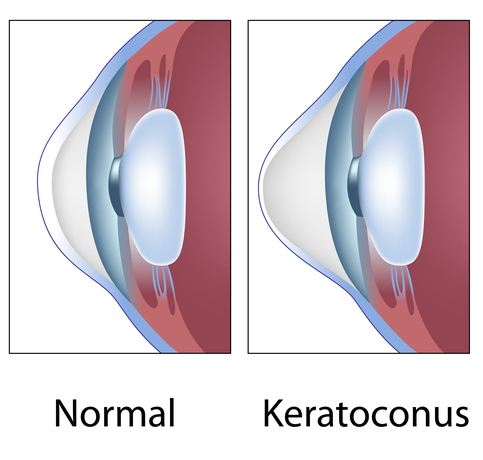Posted by: Albany Cornea | Center For Eye Care Excellence in Eye Care

The Capital Region now has access to one of the most groundbreaking advances in keratoconus treatment, thanks to Dr. Eden. As the first surgeon to bring innovative Corneal Tissue Addition Keratoplasty (CTAK) to our area, Dr. Eden is proud to offer new hope to patients with moderate to advanced keratoconus who previously faced limited treatment options.
Keep reading to discover how this innovative treatment works and whether you might be a candidate for CTAK!
What is Keratoconus?

Keratoconus is an eye condition that affects the structure and shape of your cornea. The cornea is the transparent front surface of your eye.
It refracts light entering your eye so it focuses accurately on your retina, allowing you to see clearly.
Keratoconus is when your cornea weakens and thins out, bulging into a cone-like shape. It typically begins in the late teens to early 20s with symptoms slowly worsening over time. Keratoconus usually affects both eyes, but symptoms can be different in each eye.
How is Keratoconus Treated?
Glasses and contact lenses are typically the first line of treatment for keratoconus. They can be prescribed to help improve your vision early on.
However, as keratoconus progresses, these options may not provide adequate correction of your vision. When non-surgical interventions no longer provide sufficient vision correction when the corneal structure becomes significantly compromised, you may require corneal transplant surgery.
Until recently, the only surgical option for advanced keratoconus was usually a corneal transplant. But today, procedures such as CTAK offer an excellent alternative to more invasive corneal transplantation.
What is CTAK Surgery?
Corneal tissue addition keratoplasty (CTAK) surgery is a game-changer for keratoconus patients. The procedure targets the thin or damaged layers of your cornea, typically the deep or middle layers, based on your specific needs.
CTAK involves adding donor tissue to your cornea and uses custom-shaped inlays from gamma-irradiated tissue. Gamma irradiation sterilizes the inlays, eliminating donor cells.
This decreases the risk of rejection and complications compared to a corneal transplant. The inlay reshapes and reinforces your cornea, improving corneal stability and vision.
What Happens During CTAK Surgery?

CTAK is a delicate procedure that requires precision and expertise. Dr. Eden has the expertise to navigate the complex anatomy of the cornea and perform CTAK, ensuring the best possible results.
The procedure begins with detailed mapping of your cornea to determine the actual size and shape of the required tissue inlay. A femtosecond laser is then used to precisely cut the donor cornea into the customized size and shape.
It’s also used to make a channel where the inlay will be placed. Once ready for implantation, your CTAK surgeon will carefully insert the custom-shaped inlay into the channel.
The inlay helps flatten your cornea and improve its thickness and shape. Finally, they’ll place a bandage contact lens to protect your eye as it heals.
The procedure takes about 20 minutes and is done under topical or local anesthesia with or without sedation. You can go home the same day.
Before leaving, Dr. Eden will prescribe eye drops to prevent infection and inflammation. You’ll also be given detailed post-operative care instructions, including attending follow-up appointments to monitor healing.
What are the Benefits of CTAK Surgery?
CTAK offers various advantages for keratoconus patients, including:
Personalized Treatment
The CTAK inlay is meticulously cut to match the changes in your cornea, ensuring a customized fit. This leads to more precise and personalized outcomes.
Enhanced Visual Clarity
The inlay reshapes and flattens the bulging cornea, reducing distortion and improving visual clarity. CTAK patients often experience considerable improvements in best uncorrected and corrected vision immediately after surgery.
Increased Corneal Thickness
The custom inlay adds thickness to your cornea, preventing or slowing further corneal thinning and progression of keratoconus.
Quick Recovery
CTAK surgery is less invasive than corneal transplantation. It adds an inlay to damaged areas of your cornea and preserves healthy corneal tissue. This allows for a faster, more comfortable recovery and a quicker return to regular activities.
Lower Risk of Rejection
Because CTAK donor tissue is gamma-irradiated, the risk of immune rejection is substantially lower compared to a traditional corneal transplant. Additionally, CTAK doesn’t involve complete tissue replacement, further reducing the risk of rejection.
Helps Delay or Avoid the Need for Corneal Transplantation
CTAK can stabilize the shape of your cornea and improve your vision, enough to delay or avoid a more invasive corneal transplant altogether.
Increased Independence

The vision changes caused by keratoconus can make it difficult to perform routine activities you once easily did. Reading, household chores, driving, and running errands can be challenging when your vision is compromised. CTAK offers immediate vision improvement, allowing you to reclaim your independence.
This newfound visual freedom means you can engage in everyday activities and hobbies with more ease.
Reversible
CTAX is a reversible procedure. The added inlay can be adjusted, removed, or replaced if needed, providing greater flexibility in keratoconus management.
Who is a Good Candidate for CTAK Surgery?
Not everyone is a good candidate. Generally, you may be a suitable candidate if you:
- Have moderate to advanced keratoconus
- Need more than eyeglasses, contact lenses, or corneal crosslinking
- Have a relatively healthy ocular eye surface without severe dry eye or active infections
Dr. Eden will perform a comprehensive assessment to determine whether CTAK is right for you.
Clearer Vision and Healthier Eyes with CTAK
Dr Eden is a keratoconus expert renowned for his exceptional expertise and skills. He’s proud to offer innovative CTAK surgery to keratoconus patients in the Capital Region. CTAK unlocks a new level of precision and personalization, not attainable with traditional keratoplasty, ensuring the best possible outcomes.
Do you have keratoconus? Schedule your appointment at the Center for Eye Care Excellence in Slingerlands, NY, today to find out if you’re a CTAK candidate.

